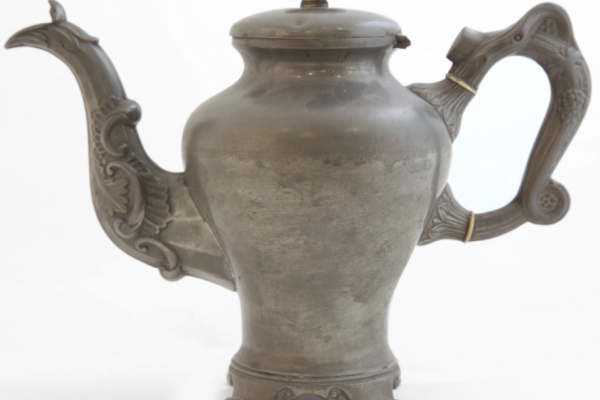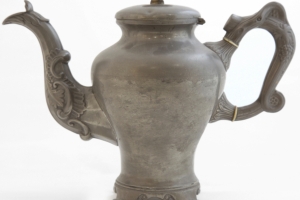
This 18th century teapot looks quite cartoonish in its form, with its little scroll feet, its plain, bulging and dull grey body, an oversized, faceted and elaborately decorated spout and a large mock-wood handle.
Apart from some small pieces of bone inlay on the handle and some pearlescent shell on the lid, this teapot is largely made from dull and dark oxidised pewter; an alloy of tin with lead, antimony, bismuth and copper. We originally thought that it was made from britannia metal, a variant of the tin alloy that is similar in colour and composition to other pewters but contains a relatively high ratio of antimony (up to 6%), which makes it harder, stronger and easier to work. However, britannia metal is thought to have been invented by James Vickers in Sheffield, 1769. This teapot has a date stamp on its bottom that suggests it was manufactured in Sheffield, 1760. Because of its age, it is unlikely that this is Britannia-ware and more likely to be an older, mildly leaded piece of pewterware.
This makes this particular teapot quite an interesting specimen, as shortly after its manufacture, pewterers generally stopped making teapots with leaded alloys, favouring britannia metal instead. Lead is toxic if inhaled or digested at high exposure levels, as it accumulates in the soft tissue and bones, damaging the nervous system and interfering with the production of red blood cells. However, lead was not banned from pewter for health reasons until the 1970s. It is more likely that pewterers gradually moved away from leaded alloys and towards antimony based pewters because they allowed for a new processing technique. Vickers found that the addition of antimony made britannia metal hard enough to form into sheet metal. Rather than being cast into expensive moulds and carved to add intricate details, as this teapot probably was, the metal could be cut, formed by hand or spun into shape, and then soldered together in a much faster and cheaper process.
Even before the development of britannia metal, ‘fine metal’ pewter alloys used for tableware tended to have a relatively low lead content and high tin content so as to resemble silver. You may be familiar with this poor-man’s silver from the low-melt casting (and now all lead-free) pewters sometimes used in jewellery making. If so, you will know that when first cast it often comes out bright and shiny, not grey and dull like this piece. This teapot would probably have been sold highly-polished to mimic silver, but has tarnished over time to become its current grey-blue hue.
Sample ID: 142
Add materials you find interesting to your own selections.
Use the  button to select a material and get started.
button to select a material and get started.




